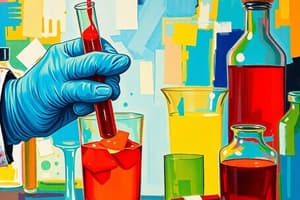Podcast
Questions and Answers
Where does glutamine synthesis take place?
Where does glutamine synthesis take place?
- Liver (correct)
- Intestine
- Stomach
- Pancreas
In which part of the body does glutamine remove the toxic effect of ammonia?
In which part of the body does glutamine remove the toxic effect of ammonia?
- Lungs
- Heart
- Skin
- Brain (correct)
Which enzyme is involved in the regulation of acid-base balance in the kidney?
Which enzyme is involved in the regulation of acid-base balance in the kidney?
- Glutathione peroxidase
- Glutamine synthetase
- Glutaminase (correct)
- Glutamate dehydrogenase
What is the principal pathway of disposal of ammonia as an end product of protein nitrogen catabolism?
What is the principal pathway of disposal of ammonia as an end product of protein nitrogen catabolism?
What is the main purpose of converting ammonia into urea in the liver?
What is the main purpose of converting ammonia into urea in the liver?
From which source is ammonia formed in the kidneys?
From which source is ammonia formed in the kidneys?
What is the catabolic fate of 60% of the excreted ammonia?
What is the catabolic fate of 60% of the excreted ammonia?
What is the anabolic fate of ammonia involving the synthesis of purines, pyrimidines, and sugaramines?
What is the anabolic fate of ammonia involving the synthesis of purines, pyrimidines, and sugaramines?
What is the primary source of blood ammonia formed from amino acids by transdeamination reactions?
What is the primary source of blood ammonia formed from amino acids by transdeamination reactions?
Where is ammonia rapidly removed from the circulation and converted into glutamate, glutamine, or urea?
Where is ammonia rapidly removed from the circulation and converted into glutamate, glutamine, or urea?
Flashcards are hidden until you start studying
Study Notes
Glutamine Synthesis and Ammonia Regulation
- Glutamine synthesis takes place in the skeletal muscle and liver.
- In the liver, glutamine removes the toxic effect of ammonia by converting it into urea.
- Carbonic anhydrase is the enzyme involved in the regulation of acid-base balance in the kidney.
- The principal pathway of disposal of ammonia as an end product of protein nitrogen catabolism is the urea cycle.
- The main purpose of converting ammonia into urea in the liver is to prevent ammonia toxicity.
- In the kidneys, ammonia is formed from the deamination of glutamine.
- 60% of excreted ammonia is catabolized to ammonium ions, which are then excreted in the urine.
- The anabolic fate of ammonia involves the synthesis of purines, pyrimidines, and sugaramines.
- The primary source of blood ammonia is amino acids, which undergo transdeamination reactions to form ammonia.
- In the liver, ammonia is rapidly removed from the circulation and converted into glutamate, glutamine, or urea.
Studying That Suits You
Use AI to generate personalized quizzes and flashcards to suit your learning preferences.




